Ultima - 1981
| Year: | 1981 |
| Original platform: | Apple II personal computer |
| Brief description: | Fantasy role-playing game (RPG) |
| Number of players: | One |
| Developers/contributors: | Richard Garriott |
Ultima was the creation of Richard Garriott de Cayeux (usually referred to simply as Richard Garriott, which was his name up until he changed it in 2011). Garriott is a prominent British-American video game developer, who in recent years has achieved even greater celebrity as one of the first civilians to go into space as a tourist. He was born to American parents in Cambridge, England in 1961. Despite his British origins, Garriott grew up in Texas, USA where he developed a keen interest in programming computers. Much of his time in high school was reportedly spent creating fantasy role-playing computer games. In the summer of 1979, Garriott obtained employment in a ComputerLand store and encountered Apple computers for the first time. The experience inspired him to create the role-playing game Akalabeth: World of Doom, the code for which he wrote in Applesoft Basic. Although the game was not originally intended to be a commercial product, the store's proprietor persuaded him that it had commercial potential.
Although his attempts to package and market the game himself did not result in many sales, a copy found its way to the offices of the California Pacific Computer Company, a software development company that specialised in publishing games and other software for the Apple II computer. They made a deal with Garriott to publish the game, which subsequently sold somewhere in the order of thirty thousand copies. Encouraged by this success, and with the help of fellow student Ken W Arnold, he went on to develop the fantasy role-playing game Ultima for the Apple II computer during his freshman year at the University of Texas. Like its predecessor, the original version of Ultima was written in Applesoft Basic. In fact, a lot of Akalabeth's program code was re-used for Ultima. The new game was also published and distributed by California Pacific, but Garriott was allegedly unhappy that it was sold in Ziploc plastic bags. His involvement with California Pacific ended when they filed for bankruptcy, not long after the publication of Ultima. The follow-up game (Ultima II: The Revenge of the Enchantress) was published in 1982 by Sierra On-Line, who had agreed to distribute the game in a box.
Garriott's relationship with Sierra was not a particularly happy one, and was consequently somewhat short-lived. In 1983, Garriott severed his ties with Sierra, and with his brother Robert set up his own company, Origin Systems. The company was established for the purpose of publishing and distributing role-playing computer games, primarily those created by Garriott himself. In that same year, Origin Systems released the third and final installment of the original Ultima trilogy, Ultima III: Exodus. In a way, Ultima was a continuation of Akalabeth: World of Doom. It certainly introduced a number of innovative features that would find their way into future role playing games, but its debt to its predecessor is such that Akalabeth has on occasion been referred to as Ultima 0, implying that it is in fact the first installment in the Ultima series of RPGs. A brief look at the features of Richard Garriott's early masterpiece thus provides us with a backdrop against which his subsequent efforts can be viewed.
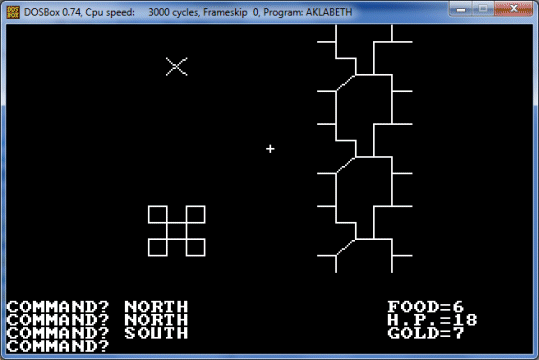
Screenshot from Akalabeth: World of Doom
(http://www.myabandonware.com/game/akalabeth-world-of-doom-3#download)
The themes encountered in Akalabeth: World of Doom reflect Garriott's interest in more traditional forms of the role-playing game, in particular Dungeons and Dragons which was created by Gary Gygax and Dave Arneson, and first published in 1974 by Tactical Studies Rules Inc. Garriott was also clearly influenced by the work of J.R.R. Tolkien, author of Lord of the Rings and The Hobbit. The main difference between Garriott's game and the Dungeons and Dragons game that in part inspired it was that his game was designed for a single player. The game is controlled by the computer program's code rather than by a human dungeon master. Nevertheless, the game retains a fantasy setting, and involves characters and creatures that will be familiar to fans of both Dungeons and Dragons and the books of J.R.R. Tolkien, including wizards, warriors and assorted monsters.
Akalabeth's graphical environment, although crude by today's standards, was at the time considered both advanced and innovative. The above-ground environment is represented as a two dimensional landscape seen from above, as you can see from the screenshot above. The main character is represented by a plus sign ("+"), which the player moves around the landscape using the keyboard. In the version we downloaded from MyAbandonware, the up, down, left and right direction keys are used for this purpose. Single boxes represent trees, while symmetrical collections of five boxes linked together represent 'adventure shops' in which you can buy supplies and weapons (or even a magic amulet), and view your current statistics. Mountain ranges are represented by a somewhat less symmetrical pattern of interconnected vertical, horizontal and diagonal lines. The castle of Lord British (from whom you receive the various quests that you must undertake in order to complete the game) consists of two much larger rectangles, one inside the other, with a large "X" in the inner rectangle.
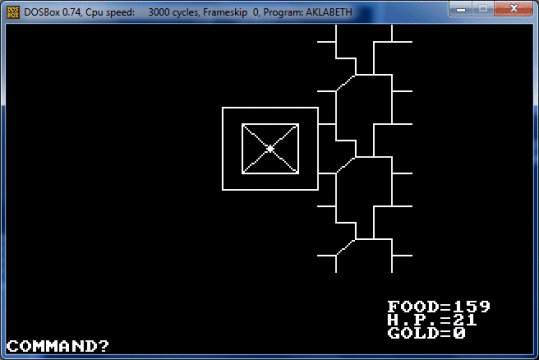
The castle of Lord British is represented by concentric rectangles
Finding the castle of Lord British is in itself far from easy. Once found, however, the player's character may enter and be assigned a quest from Lord British himself, which they must complete successfully in order to advance in the game. The name "Lord British" was apparently Garriott's nickname in school, and derives from the fact that he was born in Britain and (presumably) retained a slightly British-sounding accent. The character of Lord British would remain a central character in the Ultima series of games that followed. The quests handed out by Lord British invariably involved journeying into a 'dungeon' in order to kill some kind of creature lurking therein. The following screenshot depicts a typical dialog between our hero and Lord British upon the entry of the former to the latter's castle.
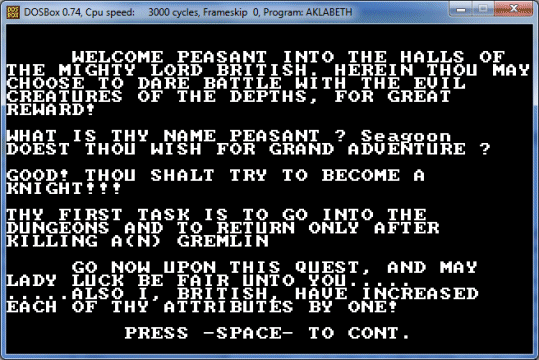
Lord British assigns the player various quests throughout the game
Once the player enters a dungeon (represented on the two-dimensional landscape by an "X"), the perspective changes to a very basic wire-frame three-dimensional first person view. The player finds themselves in a maze of underground passages in which they may encounter thieves and a variety of hostile creatures, including giant rats and bats. Whilst in the dungeon the player may accumulate gold (this is found in chests that appear in various locations), and of course carry out their designated quest, if they get an opportunity to do so. Each time the player is attacked, however, there is the likelihood that their health (represented by 'hit points') will be reduced. If the number of hit points reduces to zero, the player's character will die. Another thing to look out for is that you don't run out of food, because you can also die of starvation. Food can be purchased in any of the adventure shops that are scattered about the landscape.
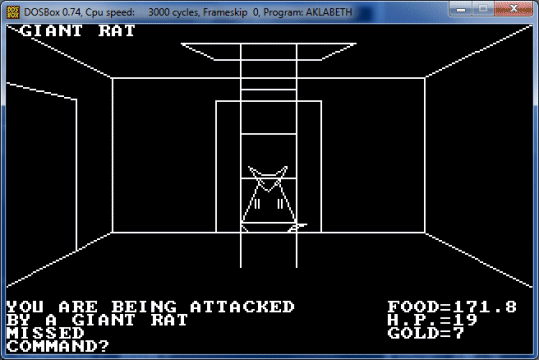
The dungeons are populated by various hostile creatures
Many sources cite Richard Garriott's Akalabeth as the first commercial graphical computer role playing game. It was certainly an important step in the evolution of the genre, and introduced features that would be copied by many of the computer-based role playing games that followed. The action is set against a background story in which Lord British, ruler of the kingdom of Akalabeth, has recently driven the evil wizard Mondain from the land. Unfortunately, many creatures loyal to Mondain remain at large, and can be found in various subterranean dungeons. The player's character accepts quests from Lord British in order to advance in rank from humble peasant to knight. The quests all involve descending into dungeons in order to seek out and destroy one of Mondain's creatures, and of course they become progressively more difficult. On first entering the game, the player has the choice of whether to play as a fighter or a mage. They can also select the level of difficulty, and make an initial purchase of food and weapons.
Many of the features first seen in Akalabeth are carried over into the Ultima series of games. Both the top-down view of the landscape and the wire-frame third person perspective of the dungeon environment are retained. Indeed, much of the code for Akalabeth was re-used for Ultima, as mentioned previously. The best-known version of Ultima is actually Ultima 1: The First Age of Darkness. This version was a re-write of the original, coded by Richard Garriott in assembly language and released in 1986. Garriott had obtained the rights to the original Ultima game from Sierra Online, and the new version was published and distributed by his own company, Origin Systems. The use of assembly language (rather than the Applesoft Basic used for the original program) made it much easier to port the game to different hardware platforms. Garriott also introduced a number of additional features and improvements, although the gameplay and background story remained unaltered.
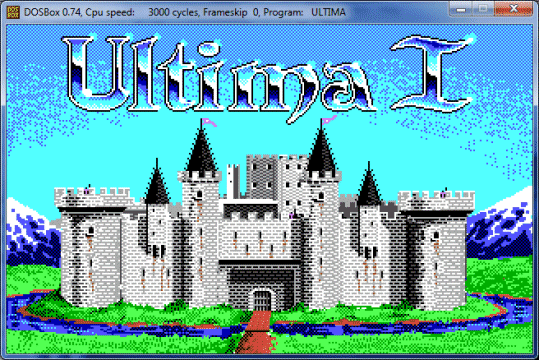
Download a playable version of Ultima 1 from the Old School Apps website
(http://www.oldschoolapps.com/downloads/roleplaying-games/259-game-ultima1)
In Ultima 1, the villain is once again the evil wizard Mondain. This time however, the world in which the action takes place is called Sosaria, and consists of four continents, each ruled by two lords. Lord British's Realm is ruled by Lord British (naturally) and the Lost King; the Lands of the Dark Unknown are ruled by Lord Olympus and the King of the Black Dragon; the Lands of Danger and Despair are ruled by Lord Shamino and the King of the White Dragon; and the Lands of the Feudal Lords are ruled by the lords of Castle Rondorin and Castle Brataria. Despite his defeat in Akalabeth: The First Age of Darkness, Mondain has returned with a vengeance and is now wreaking havoc once more, this time protected by the Gem of Immortality, which he apparently created some one thousand years in the past, and which makes him invincible. The player's character, known as "The Stranger", has apparently been summoned from another world (presumably Earth) in order to track down and destroy the Gem of Immortality so that Mondain's invincibility can be nullified. The Stranger must then defeat Mondain in combat.
At the start of the game, the player is invited to either create a new character or continue a previous game. Obviously, if this is the first time you have played the game you will choose to create a new character. The character creation screen gives you far more options than was previously the case with Akalabeth. The attributes for a character include strength, agility, stamina, charisma, wisdom and intelligence. Each attribute is automatically awarded ten points, with a further thirty points being available. The player may distribute the available points between the character's various attributes as they see fit. Obviously there is a trade-off to be made here. More points awarded to the strength attribute will mean more damage can be inflicted on an opponent in combat, but may mean that the character is less agile or has less stamina.
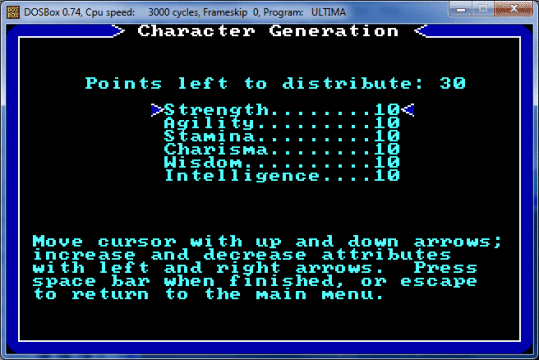
Character creation involves distrusting points among various character attributes
The next character creation screen allows the player to choose which race they want their character to be. The choices are between Human, Elf, Dwarf or Bobbit (a Bobbit is apparently a Hobbit-like creature). Depending on which race the player chooses for their character, the points allocated to each of the character's attributes may be adjusted to reflect the characteristics of that race. Elves, for example, are far more agile than Dwarves. Dwarves, on the other hand, are very strong. Further screens allow the player to choose the gender, name and class of their character. The name and gender do not affect the character's abilities in any way. The choice of class includes fighter, cleric, wizard or thief. The choice of class will also adjust the number of points that are awarded to each character attribute.
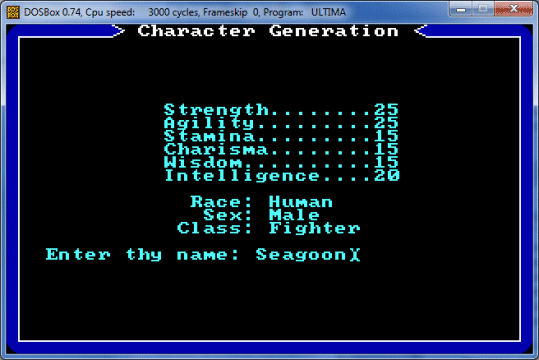
The player can also choose their character's gender, class and name
The background story is that the evil wizard Mondain has once more unleashed his hordes of malevolent creatures upon the world of Sosaria, and has used his magic to cause rifts between the various rulers of the land, rendering efforts to oppose him ineffective. Furthermore, he has attained virtual immortality thanks to his creation, some thousand years in the past, of the previously mentioned Gem of Immortality. The stranger has been informed that the only way to defeat Mondain is to travel back in time and destroy the gem before Mondain can complete it, and then meet Mondain in combat while he is still mortal. The stranger must therefore somehow find and activate a time machine which is hidden somewhere in the world of Sosaria. He can apparently achieve this only by completing eight quests, each of which is assigned by one of the eight rulers of Sosaria.
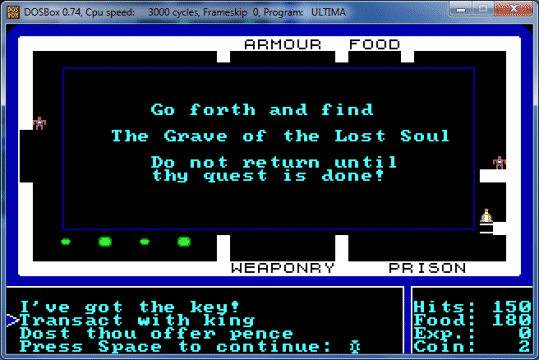
Each ruler of Sosaria will assign one quest
The reward for the successful completion of a quest takes the form of either a gem (there are four gems in total, all of a different colour) or the enhancement of some attribute vital to discovering the time machine's whereabouts and completing the game. The gems are required to activate the time machine. Quests usually involve killing a particular type of creature (which is invariably found in a dungeon) or visiting a particular place (which inevitably involves encountering a number of dangers). As the game progresses, the player will gain access to far more sophisticated forms of weaponry and transport. The various hoops that the player must jump through in order to complete the game include rescuing a princess from one of the eight castles (all of which apparently have a resident captive princess), and doing battle in outer space (in the style of Spacewars! or Asteroids).
Ultima introduced the concept of tile-based bitmapped graphics, which enabled the creation of large, colourful and relatively complex landscapes at a comparatively low cost in terms of computer memory. The game is controlled entirely using the computer's keyboard, with almost every letter of the alphabet being assigned a command. The up, down, left and right direction keys are used to move the player's character by one tile in one of the four cardinal directions (North, South, West and East) while the player is on the surface. In a dungeon, the up and down direction keys are used to move the player forwards or backwards, while the right and left direction keys rotate the player through ninety degrees clockwise or anti-clockwise. Examples of other keyboard commands include "A" for attack, "D" and "K" for descend and climb (to lower or higher levels of a dungeon respectively), "E" to enter a town or a castle (you need to be standing on the entrance at the time), and "T" to transact business with a merchant or a lord.
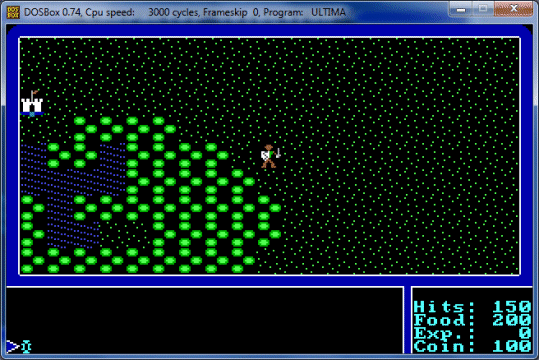
Ultima introduced the concept of tile-based graphics
As in Akalabeth, it is possible (indeed necessary for survival) to purchase various items in the many towns that are scattered around the landscape (note that entering a town or a castle loads a separate two-dimensional screen). In order to do so, the player must accumulate money (referred to as coin). Coin, which may be copper, silver or gold, can be acquired by opening coffins in dungeons, or defeating enemies (either in dungeons or above ground). Engaging in combat with the creatures encountered in the dungeons earns the player experience points, which are required in order to progress to the higher levels. Food is essential to survival (without it the player's character will starve to death), as are hit points (which represent the character's health). The acquisition of better quality weapons will also improve the chances of survival. Food is consumed relatively quickly as the player moves through the above-ground landscape, but much more slowly as the player moves around in a dungeon. No food is consumed while the player is in a town or a castle. The player can also purchase various magic spells, which may be used once only.
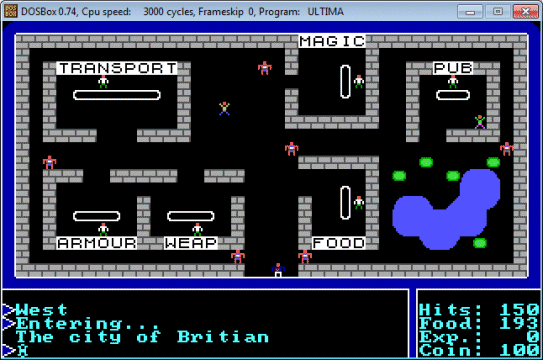
You can buy goods and services such as food, weapons, and magic spells in towns
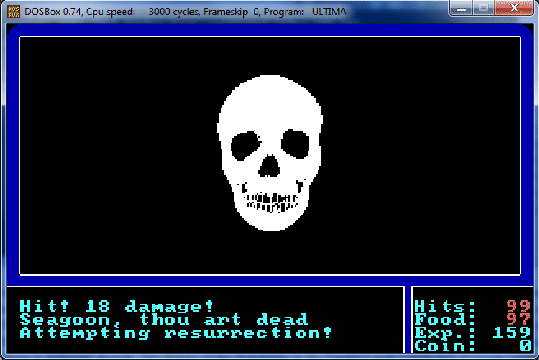
If you run out of food or hit points you will meet an untimely end
The dungeons in Ultima looked more or less the same as the dungeons in Akalabeth (which is hardly surprising, since the same code was reused for this part of the game more or less unaltered). The code itself was full of bugs, which led to some interesting side effects on occasions. In fact, when Sierra Online released Ultima I for the Atari 8-bit computers in 1982, the version they released used the same program code as the original. The Atari release therefore not only reproduced the gameplay of the original, but the glitches as well. Richard Garriott's 1986 re-write of Ultima eliminated most, if not all, of the glitches. In the meantime, versions of the game had been released for a number of popular personal computer systems besides the Apple II and the Atari 8-bit family of personal computers, including the Commodore 64 and the IBM PC.
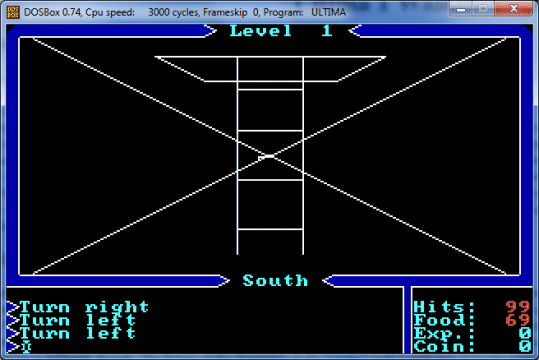
The wireframe dungeons in Ultima were created using code from Akalabeth
Origin Systems' 1986 version of Ultima, under its new name Ultima I: The First Age of Darkness, was released for a number of platforms, including the Atari 8-bit computers, the Apple II, the IBM PC and the Commodore 64. Like its predecessor, Origin's version of Ultima was released on a five-and-a-quarter inch (5.25") floppy disk. In addition, in keeping with what had already become a feature of Ultima games, the game was packaged in its own box and accompanied by a printed manual, maps of each of the four continents of Sosaria, a player reference card, and a cloth bag containing five Sosarian coins.
Ultima was the first in a long line of Ultima games. 1985 saw the fourth installment of the series, Ultima IV: Quest of the Avatar. The game included copy protection in the form of an unformatted track on the floppy disk. Pirated copies of the disk would apparently appear to function correctly, but the standard copying process could not duplicate the unformatted track. In the absence of the unformatted track, the player could never overcome an opponent in combat, and hence never progress in the game. In later versions of the game, the player was required to answer questions or translate scripts written in ancient runes in order to progress. The answers to the questions and the information required to translate the scripts could only be found in the game's manual. This feature was again no doubt intended, at least in part, to reduce the likelihood of piracy.
Perhaps more importantly there is a fundamental shift in emphasis, from Ultima IV onwards, away from simply killing monsters and completing quests and towards a narrative-driven approach. The world of Sosaria has been transformed geographically, and is now called Britannia. Lord British is now the sole ruler of Britannia. The player's character (whose ultimate goal in Ultima IV is to become an "Avatar") is faced with a number of ethical choices. The player can only become an Avatar by achieving enlightenment in the eight "virtues", which include honesty, compassion, valour, justice, honour, sacrifice, spirituality, and humility. Every significant action taken by the player's character is measured against the ideals embodied in the eight virtues, and will thus influence the player's progress towards becoming an Avatar.
In the first three installments of the Ultima series, the player could steal food, weapons or other items from shops, and even commit murder in order to progress in the game. The game reflected real life to some extent in the sense that such actions could have unfortunate consequences for the player if they were caught in the act by one of the guards. Later games in the series would develop this idea much further, to the point where every action would have a consequence, even if that consequence was not immediately obvious. Such innovations very much embodied Richard Garriott's ideas of what a role playing game should be. Although he sold Origin Systems to Electronic Arts (EA) in 1992 in order to fund his activities in the field of space exploration, he remained with the company and continued to influence the development of the Ultima series. Ultima VII: The Black Gate, released in 1992, would be the last game of the Ultima series published by Origin Systems as an independent company.
Ultima V: Warriors of Destiny was first released by Origin in 1988, and continues the story from where Ultima IV leaves off. The player's character ("The Avatar") must return once again to Britannia to rescue Lord British, who has been lost on an expedition to the Underworld, and who has been replaced as ruler by the tyrannical Lord Blackthorn. Blackthorn, under the influence of three evil and occult beings known as the Shadowlords, presides over a fundamentalist regime in which the eight "virtues" have been corrupted into a set of mandatory behaviours that are enforced through terror. The Avatar must find a way to defeat the Shadowlords, depose Blackwood, and restore the benevolent rule of Lord British. This game was the last in which a significant amount of program code was written by Richard Garriott, although he would continue to influence the design of future Ultima games.
1990 saw the release of Ultima VI: The False Prophet. In this game, Britannia has been invaded by demon-like creatures called Gargoyles. Here too, however, there is an ethical question to be resolved, as it emerges during the game that the Gargoyles have their own value system not unlike the virtues embraced by Britannia. Ultimately, the object of the game is to make this discovery and attempt to find a peaceful outcome. In technical terms, Ultima VI was a significant advance on previous installments of the Ultima story because it targeted the superior graphics capabilities of the new VGA graphics cards, which had first appeared on IBM PS/2 personal computers in 1987 and which were rapidly becoming standard equipment for the IBM PC. The game could also be set up to use a sound card to play music, and to receive input via a mouse.
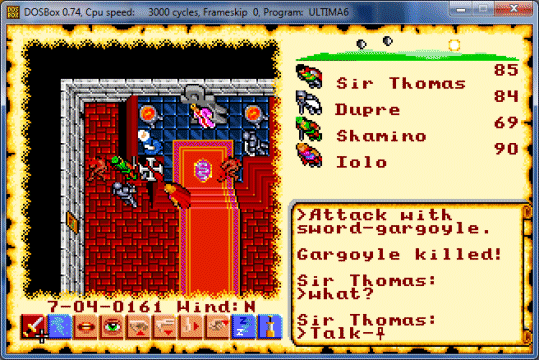
Ultima VI was designed to take advantage of the new VGA graphics cards
Ultima VII: The Black Gate was released by Origin in 1992, and was acclaimed by both game pundits and Richard Garriott himself as the best game of the Ultima series. The game's graphics were significantly better than those of previous versions, and included the use of pop-up menus. Player input could be achieved solely using a mouse, including the facility to "drag and drop" items from one location to another. The game can of course still be played using the keyboard, but this is no longer the optimal method. The game also features a much higher level of built-in intelligence for controlling both the dialog generated by non-playing characters in response to player commands or actions, and the behavior of various characters in a combat situation. The level of interactivity is also greatly enhanced, with the player able to interact in some way with nearly every object in the virtual world. In addition, although there is still a definite storyline, the player is not constrained by it. They may explore the world and carry out tasks in a (more or less) random order.
The emphasis on behaving virtuously is dropped in Ultima VII, although any reprehensible actions may still have consequences. The Avatar is once again summoned to Britannia, apparently some two centuries after the events of the previous installment, to investigate a series of gruesome murders, the activities of a mysterious religious organisation called the Fellowship, and the nature of a new antagonist called the Guardian. Unlike earlier games in the series, Ultima IV was released in two parts, both of which could be expanded by means of purchasing additional software game packs.
The Electronic Arts era inevitably brought changes for the way in which the Ultima series would develop. Ultima VIII: Pagan, released in 1994, was seen by many as a departure from the role-playing nature of previous installments. More action oriented, It was nicknamed "jump and run Ultima" by fans of the series. Perhaps due to lack of development time, the game was also notorious for software glitches. The same kind of problems would affect the final game in the series produced by EA, Ultima: Ascension, released in 1999. As a result, many fans of the series became disaffected. Garriott himself had also reached the end of the road with EA. He parted company with them in 2000, taking his brother with him. Despite all the problems however, 1997 saw the emergence of the first large-scale multiplayer online role-playing game, Ultima Online.
It was in fact Richard Garriott who first used the term massively multiplayer online role playing game (MMORPG) to describe Ultima Online. Like other Ultima games produced by EA, Ultima Online had its fair share of problems. When the game first went live, it was hosted on a single server which promptly crashed when several tens of thousands of beta testers tried to access the game. Nevertheless, the game became hugely popular, and is possibly one of EA's most successful games to date. It has undoubtedly been a major influence in the development of other MMORPGs, such as World of Warcraft. At the time of writing, Ultima Online is still going strong and can be found at Origin's Ultima Online web portal (http://www.uo.com). The site allows you to set up a free trial account, should you wish to experience Ultima Online for yourself.
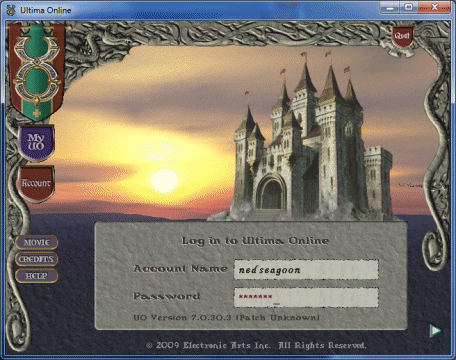
You can try Ultima online free of charge
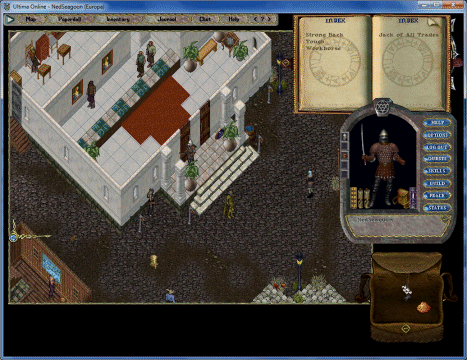
New players are encouraged to begin the game in the city of New Haven
After his departure from EA, Richard Garriott continued his involvement with the computer gaming industry, setting up a new company called Destination Games in 2000. He hired back many of the former Origin Systems personnel who had meanwhile been laid off by EA. With limited funds, however, Garriott needed to find outside backing for his new venture. This came in the form of a partnership with the South Korean company NCSoft, who shortly after the release of Ultima Online had developed their own highly successful MMORPG, called Lineage, which had several million subscribers (mostly in in South Korea). Despite their success in Korea, NCSoft were virtually unknown in the US. A partnership with Destination Games was exactly what they needed to raise their profile there. Destination Games could also provide a number of highly experienced game developers. In return, they would receive the funding they needed. Destination Games duly became NCSoft Austin.
Richard Garriott held the position of CEO at NCSoft Austin, where (among other things) he oversaw the development of MMORPGs such as the innovative but ultimately ill-fated Tabula Rasa. In 2008, Garriott apparently published an open letter on the Tabula Rasa gaming website stating his intention to leave NCSoft in order to concentrate on other interests. He later filed a lawsuit against NCSoft on the grounds that he had been forced out, and that the letter had been forged as a means to facilitate his removal. Meanwhile he established a new company, Portalarium, in 2009. Portalarium develops and publishes games for the social media market, and with Garriott at the helm is reported to be working on a "spiritual successor" to the Ultima series, Shroud of the Avatar: Forsaken Virtues, which is scheduled for release at the end of 2014. According to his statement on Portalarium's website, Garriott is continuing his own lifelong quest to create the "Ultimate Role Playing Game".
